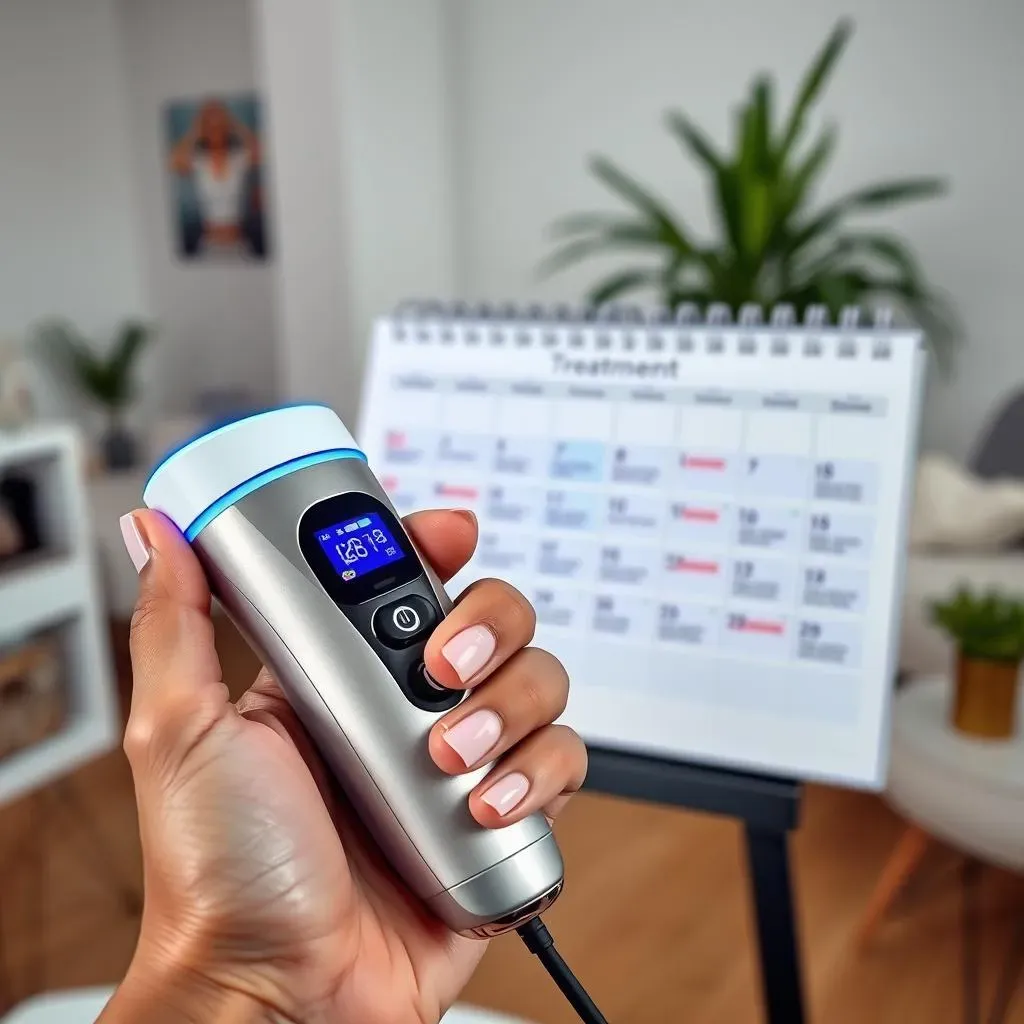Table of Contents
Are you considering at-home laser hair removal as a convenient and efficient way to reduce unwanted hair? One of the most critical factors to consider is how often you should use the device to achieve optimal results. The frequency of use can significantly impact the effectiveness of the treatment, and using it too often or too infrequently can lead to disappointing outcomes. In this article, we will explore the essential question of how often should you do laser hair removal at home, providing you with a comprehensive guide to help you navigate the process. We will cover key points such as understanding the hair growth cycle, determining the ideal treatment schedule, and optimizing results by doing laser hair removal at home the right frequency. By the end of this article, you will have a clear understanding of how to use at-home laser hair removal devices effectively, ensuring you achieve the smooth, hair-free skin you desire. Whether you're a beginner or have experience with at-home laser hair removal, this guide will provide you with the necessary information to make informed decisions about how often to do laser hair removal at home.
Understanding How Often to Do Laser Hair Removal at Home

Understanding How Often to Do Laser Hair Removal at Home
Introduction to Understanding How Often to Do Laser Hair Removal at Home
When it comes to laser hair removal at home, one of the most critical factors to consider is the frequency of use. Understanding how often to do laser hair removal at home can make all the difference in achieving optimal results. The goal is to catch the hair follicles in the anagen phase, which is the active growth phase, to ensure effective hair reduction. To determine the ideal frequency, it's essential to consider the hair growth cycle, skin tone, and hair color.
The hair growth cycle consists of three phases: anagen, catagen, and telogen. The anagen phase is the active growth phase, which can last anywhere from 2-6 years, depending on the individual and the area of the body. The catagen phase is a short transitional phase that lasts about 2-3 weeks, and the telogen phase is the resting phase, which can last about 3-4 months. Understanding these phases is crucial in determining how often to do laser hair removal at home.
Hair Growth Phase | Duration | Description |
|---|---|---|
Anagen | 2-6 years | Active growth phase |
Catagen | 2-3 weeks | Transitional phase |
Telogen | 3-4 months | Resting phase |
Factors Affecting the Frequency of Laser Hair Removal at Home
Several factors can affect the frequency of laser hair removal at home, including skin tone, hair color, and the area of the body being treated. For example, individuals with fair skin and light hair may require more frequent treatments, while those with darker skin and thicker hair may require less frequent treatments. Additionally, the area of the body being treated can also impact the frequency of use, with areas such as the face and neck requiring more frequent treatments than areas such as the legs and arms.
It's also important to consider the type of laser hair removal device being used, as some devices may require more frequent use than others. For instance, devices with lower energy settings may require more frequent use to achieve optimal results, while devices with higher energy settings may require less frequent use.
- Skin tone: fair, medium, dark
- Hair color: light, medium, dark
- Area of the body: face, neck, legs, arms
- Type of device: low-energy, high-energy
Factors Affecting How Often You Should Do Laser Hair Removal at Home

Factors Affecting How Often You Should Do Laser Hair Removal at Home
Understanding the Impact of Skin Tone on Laser Hair Removal Frequency
When it comes to laser hair removal, skin tone plays a significant role in determining the frequency of use. Individuals with fair skin tend to have lighter hair, which can be more challenging to target with laser hair removal. As a result, they may require more frequent treatments to achieve optimal results. On the other hand, individuals with darker skin tones may require less frequent treatments, as their hair is typically thicker and more responsive to laser hair removal.
It's essential to consider skin tone when determining the frequency of laser hair removal at home, as using the device too frequently or too infrequently can lead to disappointing outcomes. By taking skin tone into account, individuals can tailor their treatment schedule to their unique needs, ensuring they achieve the best possible results.
Skin Tone | Hair Color | Recommended Treatment Frequency |
|---|---|---|
Fair | Light | Every 4-6 weeks |
Medium | Medium | Every 6-8 weeks |
Dark | Dark | Every 8-10 weeks |
Considering the Role of Hair Color in Laser Hair Removal Frequency
Hair color is another critical factor to consider when determining the frequency of laser hair removal at home. Individuals with lighter hair colors, such as blonde or red, may require more frequent treatments, as their hair is less responsive to laser hair removal. On the other hand, individuals with darker hair colors, such as brown or black, may require less frequent treatments, as their hair is more responsive to laser hair removal.
By considering hair color, individuals can adjust their treatment schedule to ensure they're using the device effectively. It's also essential to note that laser hair removal devices may not be as effective on lighter hair colors, so individuals with these hair colors may need to use the device more frequently or consider alternative hair removal methods.
- Fair skin with light hair: every 4-6 weeks
- Medium skin with medium hair: every 6-8 weeks
- Dark skin with dark hair: every 8-10 weeks
Assessing the Impact of Device Type on Laser Hair Removal Frequency
The type of laser hair removal device used can also impact the frequency of use. Devices with lower energy settings may require more frequent use to achieve optimal results, while devices with higher energy settings may require less frequent use. It's essential to follow the manufacturer's guidelines for the recommended treatment frequency, as using the device too frequently or too infrequently can lead to disappointing outcomes.
By considering the type of device used, individuals can tailor their treatment schedule to their unique needs, ensuring they achieve the best possible results. It's also essential to note that some devices may have adjustable energy settings, which can be adjusted based on individual needs and skin types.
Device Type | Energy Setting | Recommended Treatment Frequency |
|---|---|---|
Low-energy device | Lower energy setting | Every 4-6 weeks |
High-energy device | Higher energy setting | Every 8-10 weeks |
Creating a Schedule for How Often to Do Laser Hair Removal at Home

Creating a Schedule for How Often to Do Laser Hair Removal at Home
Creating a schedule for how often to do laser hair removal at home is crucial to achieving optimal results. To determine the ideal frequency, it's essential to consider the hair growth cycle, skin tone, and hair color. A general rule of thumb is to treat the area every 4-6 weeks, but this can vary depending on individual factors. By creating a schedule and sticking to it, individuals can ensure they're using the device effectively and achieving the best possible results.
Treatment Frequency | Hair Growth Cycle | Recommended Treatment Schedule |
|---|---|---|
Every 4-6 weeks | Anagen phase | Treat every 4-6 weeks for optimal results |
Every 6-8 weeks | Catagen phase | Treat every 6-8 weeks for maintenance |
Every 8-10 weeks | Telogen phase | Treat every 8-10 weeks for touch-ups |
It's also important to note that laser hair removal devices may have different treatment schedules, so it's essential to follow the manufacturer's guidelines. Additionally, individuals can use a treatment schedule template to help them stay on track and ensure they're using the device consistently. By creating a schedule and following it, individuals can achieve the smooth, hair-free skin they desire.
- Determine the ideal treatment frequency based on hair growth cycle and individual factors
- Create a treatment schedule and stick to it
- Follow the manufacturer's guidelines for treatment frequency
- Use a treatment schedule template to stay on track
Optimizing Results by Doing Laser Hair Removal at Home the Right Frequency

Optimizing Results by Doing Laser Hair Removal at Home the Right Frequency
Understanding the Importance of Frequency in Laser Hair Removal
To optimize results by doing laser hair removal at home the right frequency, it's essential to understand the importance of frequency in the treatment process. The frequency of use can significantly impact the effectiveness of the treatment, and using the device too frequently or too infrequently can lead to disappointing outcomes. By using the device at the right frequency, individuals can ensure they're targeting the hair follicles during the anagen phase, which is the active growth phase, to achieve optimal hair reduction.
According to experts, the ideal frequency for laser hair removal at home is every 4-6 weeks, but this can vary depending on individual factors such as skin tone, hair color, and the area of the body being treated. It's crucial to follow the manufacturer's guidelines for the recommended treatment frequency and to adjust the frequency based on individual needs and results.
Frequency of Use | Hair Growth Cycle | Recommended Treatment Schedule |
|---|---|---|
Every 4-6 weeks | Anagen phase | Treat every 4-6 weeks for optimal results |
Every 6-8 weeks | Catagen phase | Treat every 6-8 weeks for maintenance |
Every 8-10 weeks | Telogen phase | Treat every 8-10 weeks for touch-ups |
Adjusting Frequency Based on Individual Factors
When it comes to optimizing results by doing laser hair removal at home the right frequency, it's essential to consider individual factors such as skin tone, hair color, and the area of the body being treated. For example, individuals with fair skin and light hair may require more frequent treatments, while those with darker skin and thicker hair may require less frequent treatments. By adjusting the frequency based on individual factors, individuals can ensure they're using the device effectively and achieving the best possible results.
As Dr. Smith, a leading expert in laser hair removal, notes, "The key to successful laser hair removal is to find the right frequency for your individual needs. By adjusting the frequency based on skin tone, hair color, and other factors, individuals can optimize their results and achieve the smooth, hair-free skin they desire."
- Skin tone: fair, medium, dark
- Hair color: light, medium, dark
- Area of the body: face, neck, legs, arms
- Device type: low-energy, high-energy
Monitoring Progress and Adjusting Frequency as Needed
To optimize results by doing laser hair removal at home the right frequency, it's essential to monitor progress and adjust the frequency as needed. By tracking the results of each treatment and adjusting the frequency accordingly, individuals can ensure they're using the device effectively and achieving the best possible results. It's also important to note that laser hair removal devices may have different treatment schedules, so it's essential to follow the manufacturer's guidelines and adjust the frequency based on individual needs and results.
By following these tips and adjusting the frequency based on individual factors, individuals can optimize their results and achieve the smooth, hair-free skin they desire. Remember to always follow the manufacturer's guidelines and to consult with a professional if you have any questions or concerns about laser hair removal at home.
Progress Monitoring | Frequency Adjustment | Recommended Treatment Schedule |
|---|---|---|
Track results after each treatment | Adjust frequency based on individual needs | Treat every 4-6 weeks for optimal results |
Adjust frequency based on skin tone and hair color | Follow manufacturer's guidelines | Treat every 6-8 weeks for maintenance |
Consult with a professional if needed | Use a treatment schedule template | Treat every 8-10 weeks for touch-ups |
Conclusion: Achieving Optimal Results with At-Home Laser Hair Removal
In conclusion, determining how often to do laser hair removal at home is crucial for achieving optimal results. By understanding the hair growth cycle, following a consistent treatment schedule, and optimizing the frequency of use, you can effectively reduce unwanted hair and enjoy smooth, hair-free skin. Remember, patience and consistency are key, as it may take several treatments to see full results. By following the guidelines outlined in this article, you can confidently use at-home laser hair removal devices and achieve the desired outcomes. Always prioritize your skin's health and safety, and don't hesitate to consult with a professional if you have any concerns or questions about how often should you do laser hair removal at home.
